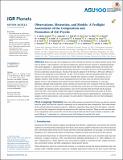Observations, Meteorites, and Models: A Preflight Assessment of the Composition and Formation of (16) Psyche
Author(s)
Elkins-Tanton, LT; Asphaug, E; Bell, JF; Bercovici, H; Bills, B; Binzel, R; Bottke, WF; Dibb, S; Lawrence, DJ; Marchi, S; McCoy, TJ; Oran, R; Park, RS; Peplowski, PN; Polanskey, CA; Prettyman, TH; Russell, CT; Schaefer, L; Weiss, BP; Wieczorek, MA; Williams, DA; Zuber, MT; ... Show more Show less
DownloadPublished version (4.186Mb)
Publisher with Creative Commons License
Publisher with Creative Commons License
Creative Commons Attribution
Terms of use
Metadata
Show full item recordAbstract
© 2020. The Authors. Some years ago, the consensus was that asteroid (16) Psyche was almost entirely metal. New data on density, radar properties, and spectral signatures indicate that the asteroid is something perhaps even more enigmatic: a mixed metal and silicate world. Here we combine observations of Psyche with data from meteorites and models for planetesimal formation to produce the best current hypotheses for Psyche's properties and provenance. Psyche's bulk density appears to be between 3,400 and 4,100 kg m−3. Psyche is thus predicted to have between ~30 and ~60 vol% metal, with the remainder likely low-iron silicate rock and not more than ~20% porosity. Though their density is similar, mesosiderites are an unlikely analog to bulk Psyche because mesosiderites have far more iron-rich silicates than Psyche appears to have. CB chondrites match both Psyche's density and spectral properties, as can some pallasites, although typical pallasitic olivine contains too much iron to be consistent with the reflectance spectra. Final answers, as well as resolution of contradictions in the data set of Psyche physical properties, for example, the thermal inertia measurements, may not be resolved until the NASA Psyche mission arrives in orbit at the asteroid. Despite the range of compositions and formation processes for Psyche allowed by the current data, the science payload of the Psyche mission (magnetometers, multispectral imagers, neutron spectrometer, and a gamma-ray spectrometer) will produce data sets that distinguish among the models.
Date issued
2020Department
Massachusetts Institute of Technology. Department of Earth, Atmospheric, and Planetary SciencesJournal
Journal of Geophysical Research: Planets
Publisher
American Geophysical Union (AGU)